Auricularia polytricha noodles prevent hyperlipemia and modulate gut microbiota in high-fat diet fed mice
2021-05-24DongluFngDnWngGoxingYngJiHuihuZhengHuiChenMingwenZhoQiuhuiHuLiynZho
Donglu Fng, Dn Wng, Goxing M, Yng Ji, Huihu Zheng,c, Hui Chen,c, Mingwen Zho, Qiuhui Hu, Liyn Zho,*
a College of Food Science and Technology, Nanjing Agricultural University/Key Laboratory of Edible Mushroom Processing, Ministry of Agriculture and Rural Affairs, Nanjing 210095, China
b College of Food Science and Engineering, Nanjing University of Finance and Economics, Nanjing 210023, China
c Jiangsu Alphay Bio-technology Co., Ltd., Nantong 226009, China
d College of Life Sciences, Nanjing Agricultural University, Nanjing, Jiangsu 210095, China
Keywords:Auricularia polytricha noodles Hyperlipidemia Lipid metabolism Gut microbiota
ABSTRACT Auricularia polytricha possesses hypolipidemic effects and decreases lipid accumulation, leading to potential food additives for functional food processing.In this research, we explored the potential effects of A.polytricha noodles on hyperlipidemia and gut microbiota dysbiosis, and elucidated their possible regulatory mechanisms on lipid metabolism in high-fat diet (HFD) mice.A.polytricha n oodles treatment signifi cantly (P < 0.05) reduced body weight gain, hyperlipidemia and liver fat accumulation.Meanwhile, A.polytricha noodles decreased the levels of serum total cholesterol (TC), total triglyceride (TG) and low-density lipoprotein cholesterol (LDL-C) compared with the HFD group.Furthermore, A.polytricha noodles could enrich the diversity of gut microbiota by decreasing the ratio of Firmicutes to Bacteroidetes as well as the relative abundance of Deferribacteres and increased the relative abundance of Verrucomicrobia, which might contribute to the prevention of hyperlipidemia.This study indicated that A.polytricha noodles could modulate the gut microbiota and prevent hyperlipidemia and liver fat accumulation induced by HFD.
1.Introduction
Auricularia polytricha, also called Jew’s Ear or wood ear, belongs to Auriculariaceae family and is a main variety of edible mushrooms cultivated in China.A.polytrichais frequently consumed around the world, especially in East and Southeast Asia [1].It contains various health-promoting bioactive substances including poly saccharides, proteins, fibers and minerals [2,3].Poly saccharides are considered as the main functional ingredients inA.polytricha, which contribute to most of the observed beneficial effects [4].With its abundance of nutrients and large production yield,A.polytricha, however, is rarely processed and mainly sold in dried or fresh forms.It is thus incumbent upon researchers to develop and refi ne the processing ofA.polytricha.It is against this backdrop that a new noodle product was successfully processed withA.polytrichain our previous study [5], but its functional characteristics are still unclear.
Accumulation of evidence over the last decades has proved thatA.polytrichapossesses various pharmacological properties including antioxidant [6], antitumor [7], hypolipidemic [8]and hypoglycemic [9]effects.Several studies have demonstrated thatA.polytrichaand its aqueous extract decreased the serum lipid concentrations [10]and hepatic lipid accumulation [2]in animals.In addition, the dietary fibre ofA.polytrichaexhibited hypoglycemic effectsin vitro[9], while the exo-biopolymer fromA.polytrichashowed hypolipidemic effects in rats [11].Lately, the relationship between diet, human health and gut microbiota has been the focus of many studies [12].An unbeneficial microbiota composition, known as microbiota dysbiosis, is associated with cardiometabolic disorders like hyperlipidemia and obesity [13].Diets composed edible mushrooms [3], whole grains [14]and olive oil [15]may alter the composition of gut microbiota and ameliorate dysbiosis.However, it is unclear whetherA.polytrichastill has hypolipidemic effects after inclusion into noodles and there are no reports analyzingA.polytrichaor its products from the perspective of gut microbiota.
Therefore, we explored the potential role ofA.polytrichanoodles in the prevention of hyperlipidemia and investigated the relationship betweenA.polytrichanoodles and gut microbiota.In this study, we established a model using high-fat diet (HFD) induced hyperlipidemia mice and fed the mice withA.polytrichanoodles for 8 weeks.The physical and chemical indicators of lipid metabolism were determined and the histopathological sections of the liver were photographed.Additionally, the faecal DNA was analyzed for illustrating gut microbiota variation in mice through high-throughput sequencing analysis.We hypothesized thatA.polytrichanoodles could prevent hypolipidemia in HFD-fed mice by enriching the diversity of gut microbiota and ameliorating its dysbiosis.
2.Materials and methods
2.1 Materials and reagents
A.polytrichagranules (particle size of 200 mesh) were provided by Zhangzhou Comprehensive Experiment Station (Zhangzhou, China).Refined wheat flour was purchased from a local market (Nanjing, China).The proximate composition of the flour (11.7% moisture, 12.2% crude protein, 70.9% starch and 0.7% ash) was provided by the manufacturer.Based on the manufacturer’s information, the commercial noodles were made from water and refined wheat flour at a ratio of 42:58 (m/m).TheA.polytrichanoodles were produced following the same procedure with 20% wheat flour replaced withA.polytrichagranules.The nutritional components ofA.polytrichaand its derived noodles were analyzed and shown in Table 1.
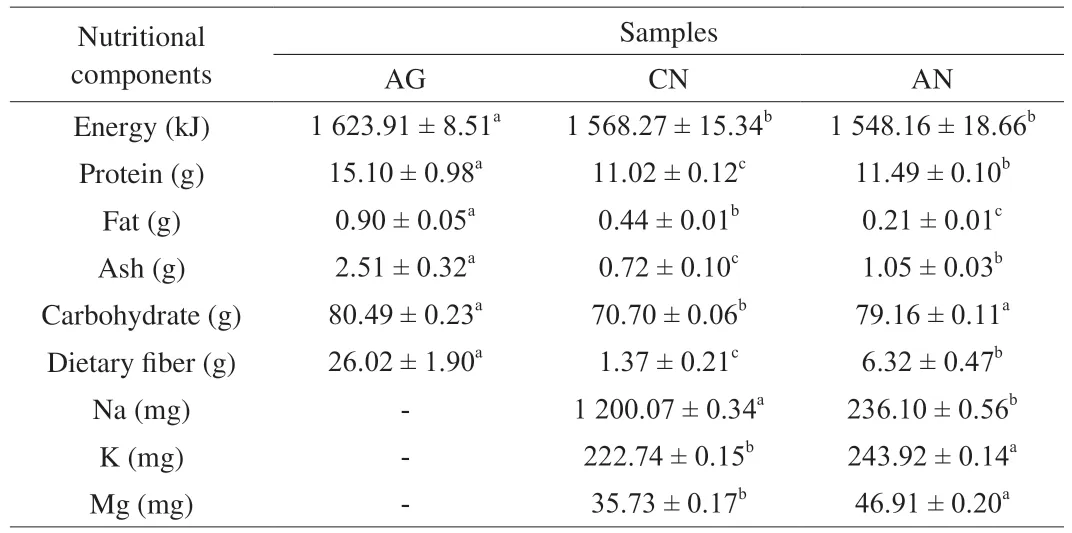
Table 1 The nutritional components analysis of A.polytricha and its derived noodles.
The commercially available kits of serum total cholesterol (TC), total triglyceride (TG), low-density lipoprotein cholesterol (LDL-C), high-density lipoprotein cholesterol (HDL-C), alanine aminotransferase (ALT), aspartate aminotransferase (AST), adiponectin (ADPN) and leptin (LEP) in serum were purchased from Nanjing Jiancheng Bioengineering Institute (Nanjing, China).All other chemical reagents used were of analytical grade.
2.2 Animals and diet
Seven-week-old C57BL/6N male mice (specific-pathogen-free grade, body weight (20.0 ± 2.0) g,n= 48) were purchased from Comparative Medicine Centre of Yangzhou University (Yangzhou, China, SCXK<Jiangsu>2017-0007).The experimental procedure was performed at the Animal Experiment Center of Nanjing Agricultural University (Nanjing, China, SYXK<Jiangsu>2017-0007) according to the National Guidelines for Experimental Animal Welfare (Ministry of Science and Technology of the People’s Republic of China, 2006).Each mouse was acclimated to its new living conditions of (25 ± 2) °C, a relative humidity of (50 ± 5)% and a 12/12 h light-dark cycle withad libitumaccess to diet and water for one week.
The mice were then randomly divided into 6 treatment groups (NC, HFD, AN-L, AN-H, HFD + ANL, and HFD + ANH, 8 mice per group): (1) In NC group, the mice were fed with low-fat diet (MD12031,10% calories from fat); (2) In HFD group, the mice were fed with high-fat diet (MD12032, 45% calories from fat) and regarded as a model of hyperlipemia and intestinal dysbiosis; (3) In AN-L group, the mice were fed with normal-chow diet fixed with low dose ofA.polytrichanoodles (MD12031, 10% calories from fat); (4) In AN-H group, the mice were fed with normal-chow diet fixed with high dose ofA.polytrichanoodles (MD12031, 10% calories from fat); (5) In HFD + ANL group, the mice were fed with high-fat diet fixed with low dose ofA.polytrichanoodles (MD12032, 45% calories from fat); (6) In HFD + ANH group, the mice were fed with high-fat diet fixed with high dose ofA.polytrichanoodles (MD12032, 45% calories from fat).All the groups were maintained for 8 weeks.The diets were purchased from Jiangsu Medicience Ltd.(Yangzhou, China) and its compositions and nutritional ingredients were shown in Table 2.The food intake and body mass were measured weekly.The faeces, serum, liver, kidney, perirenal adipose tissue and epididymal adipose tissue were collected at the end of experiment, immediately frozen in liquid nitrogen and stored at -80 °C prior to analysis.
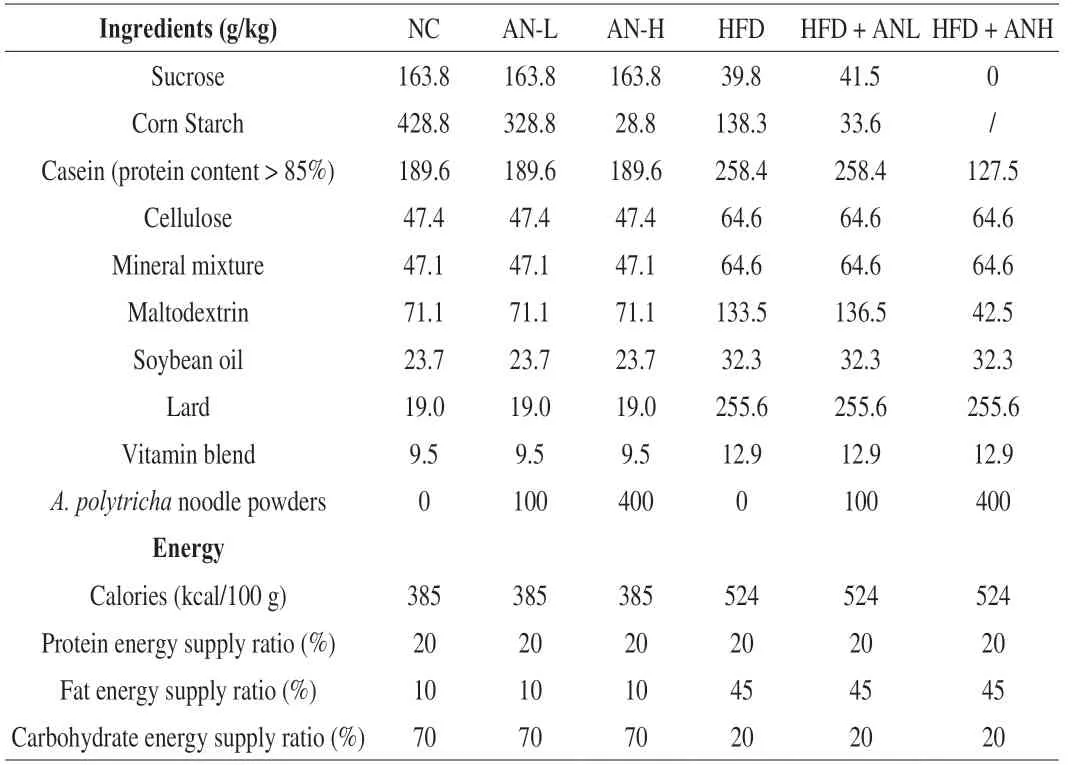
Table 2 Compositions and nutritional ingredients of the experimental diets.
2.3 Analysis of serum lipid profiles and liver histology
The contents of serum TC, TG, LDL-C, HDL-C, ALT, AST, ADPN and LEP were analyzed with enzymatic assay kits according to the manufacturer’s instructions.
A portion of liver sample of mice was sectioned into blocks and fixed in 4% paraformaldehyde for histopathological analysis.The fixed tissues were dehydrated by a graded series of ethanol, embedded in paraffin, cut into slices (6 μm), and placed on glass slides.Oil Red O staining was carried out according to the standard method, and the stain result was observed by light microscopy at 100 × magnification.The liver samples were then photographed and analyzed.
2.4 Fecal DNA extraction and high throughput sequencing analysis
The fecal genomic DNA was extracted by QIAamp DNA stool Mini Kit (NO.51504, Qiagen, Germany).For each fecal sample, the sequencing and bioinformatics analysis were carried out by Genesky Biotechnologies Inc.(Shanghai, China) on the Illumina MiSeq platform to generate 2 × 250 bp paired-end reads.The resulting DNA was amplified with barcoded specific bacterial primers targeting the 16S rRNA gene V4 region using primers 341F (5’-CCTACGGGNGGCWGCAG-3’) and 785R (5’-GACTACHVGGGTATCTAATCC-3’).High fidelity PCR was used to introduce specific sequence tags with Index sequences according to the requirements of library construction.After the library quantification and qualification, samples were pooled in equimolar amount.The alpha-diversity analyses including Shannon diversity indices and Simpson diversity indices were used by MOTHUR software (Version 1.35.1, https://mothur.org/).The community structure comparisons were compared on the MOTHUR program and R software (Version 2.15.3, http://www.r-project.org/).
2.5 Body weight and viscera index detection
The body weight was measured weekly to monitor growth and development of the mice.At the end of the experimental period, all the mice were sacrificed.The weight of organs (liver and kidney) and fat of each mouse were measured.
The viscera indices were calculated using the formula: liver, kidney, epididymal fat and perinephric fat index = liver, kidney, epididymal fat and perinephric fat weight (g)/body weight (g).
2.6 Ethics statement
Animals were maintained in accordance with the guidelines of the National Institutes of Health guide for the care and use of Laboratory animals (NIH Publications No.8023, revised 1978).
2.7 Statistical analysis
The data are presented as mean ± standard deviation.One-way analysis of variance procedure followed by Tukey test was used to evaluate the statistical significance by SPSS 22 software (IBM, Chicago, USA).
3.Results
3.1 Effect of A.polytricha noodles on body weight and organ parameter in mice
During the 8-week HFD feeding trial, the significant increases (P< 0.05) in the weights of body, liver and kidney as well as accumulation of epididymal and perinephric fats were observed (Table 3 and Table 4).Dietary supplementation withA.polytrichanoodles to HFD-fed mice could significantly attenuate body weight gain, which coincided with significant reductions in accumulation of liver weight, epididymal and perinephric fats.In detail, the body weight of HFD + ANH and HFD + ANL groups had no significant difference (P> 0.05) in comparison with that of NC group while the body weight of AN-L and AN-H groups decreased significantly (Table 3).Liver indices of AN-L, AN-H, HFD + ANL and HFD + ANH groups had no significant difference compared with that of NC group.The AN-H and HFD + ANH groups showed lower epididymal and perinephric fat indices than NC group while no significance difference was found in AN-L and HFD + ANL groups (Table 4).Furthermore, the epididymal and perirenal fat indices of HFD + ANL decreased by 41.20% and 46.43% respectively, while in HFD + ANH group the indices decreased by 63.54% and 70.47% compared with HFD.However, the food intake of HFD + ANL and HFD + ANH groups was significantly higher than that of HFD group (Table 3).

Table 3 Body weight and total intake of mice in 6 groups during the 8-week feeding trial.

Table 4 Viscera index, epididymal fat index and perinephric fat index of each group at the end of the experiment.
3.2 Effect of A.polytricha noodles on serum lipid profiles
Compared with NC group, the serum TC, TG and LDL-C contents of HFD group increased while HDL-C level decreased significantly (P< 0.05) (Table 5).After treatment withA.polytrichanoodles for 8 weeks, the serum TC, TG and LDL-C of AN-L, AN-H, HFD + ANL and HFD + ANH groups decreased significantly compared to those of HFD group.The serum TC and TG reductions caused byA.polytrichanoodles were 1.18 and 1.59 mmol/L for HFD + ANL group, and 1.27 and 1.64 mmol/L for HFD + ANH group.However, compared with NC group, the serum TC and TG increased by 0.06 and 0.09 mmol/L for AN-L group, and 0.09 and 0.06 mmol/L for AN-H group.The serum lipid profiles showed that both low and high dose ofA.polytrichanoodles could produce significant hypolipidemic effect in HFD-fed mice.

Table 5 Lipid profiles of each group at the end of the experiment.
3.3 Effect of A.polytricha noodles on ALT and AST activities in serum and liver
The measured ALT and AST activities in mice are shown in Fig.1.High fat diet causes an oxidative stress in the liver and results in increases in ALT and AST levels [16].Compared with HFD group, ALT and AST activities in serum and liver decreased significantly (P< 0.05) in HFD + ANL and HFD + ANH groups.Average serum ALT and AST reductions of HFD + ANL group were 64.55% and 53.10% as well as 62.90% and 50.98% for HFD + ANH group (Fig.1A, 1B), while average liver ALT and AST reductions were 48.09% and 56.98% for HFD + ANL group as well as 55.60% and 53.74% for HFD + ANH group (Fig.1C, 1D).There was no significant difference (P> 0.05) between NC and the groups only treated withA.polytrichanoodles (AN-L and AN-H).The results showed thatA.polytrichanoodles could prevent HFD-induced liver injury in mice.
3.4 Effect of A.polytricha noodles on serum ADPN and LEP level in mice
ADPN and LEP are secreted by adipocytes and have positive correlation with adipose tissue changes of body [17].As shown in Fig.1E and 1F, the ADPN and LEP contents of HFD group increased significantly (P< 0.05) compared to those of NC.However, the dietary supplementation withA.polytrichanoodles could significantly attenuate the gain of ADPN and LEP levels.There was no significant difference (P> 0.05) between HFD + ANH and NC groups both at ADPN and LEP levels.The results showed thatA.polytrichanoodles could inhibit HFD-induced obesity.
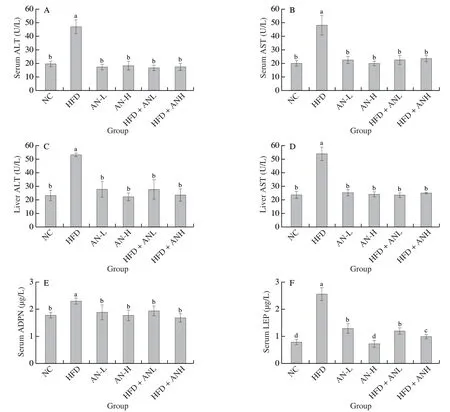
Fig.1 Effect of A.polytricha noodles on ALT, AST, ADPN and LEP levels.Serum ALT (A), serum AST (B), liver ALT (C), liver AST (D), serum ADPN (E) and Serum LEP (F) levels were measured.Values are expressed as the mean ± standard deviation.Different lowercase letters mean significant difference (P < 0.05) between different groups.
3.5 Effect of A.polytricha noodles on liver histopathology
Histological sections of NC group showed that hepatocytes were well-preserved, normal hepatic cell with central vein, uniform cytoplasm and sinusoidal spaces (Fig.2).Compared with NC, the sample in HFD group revealed extensive liver injuries characterized by severe hepatocellular degeneration, large areas and increased volume of red lipid droplets in both central and portal veins.A.polytrichanoodles-treated groups (HFD + ANL and HFD + ANH) protected the liver tissue against HFD-induced hepatocellular fat accumulation, with less lipid droplets and well-preserved hepatocytes observed in most areas compared with that of HFD group.The recovery from hepatocellular fat accumulation of HFD + ANH group animals was comparable to that ofA.polytrichanoodles treated AN-H group animals.The results revealed thatA.polytrichanoodles could alleviate HFD-induced hepatic lipid degeneration and promote the recovery from liver injury by inhibiting hepatocellular fat accumulation and this was consistent with the results of serum lipid determination.
3.6 Effect of A.polytricha noodles on overall structural change of gut microbiota
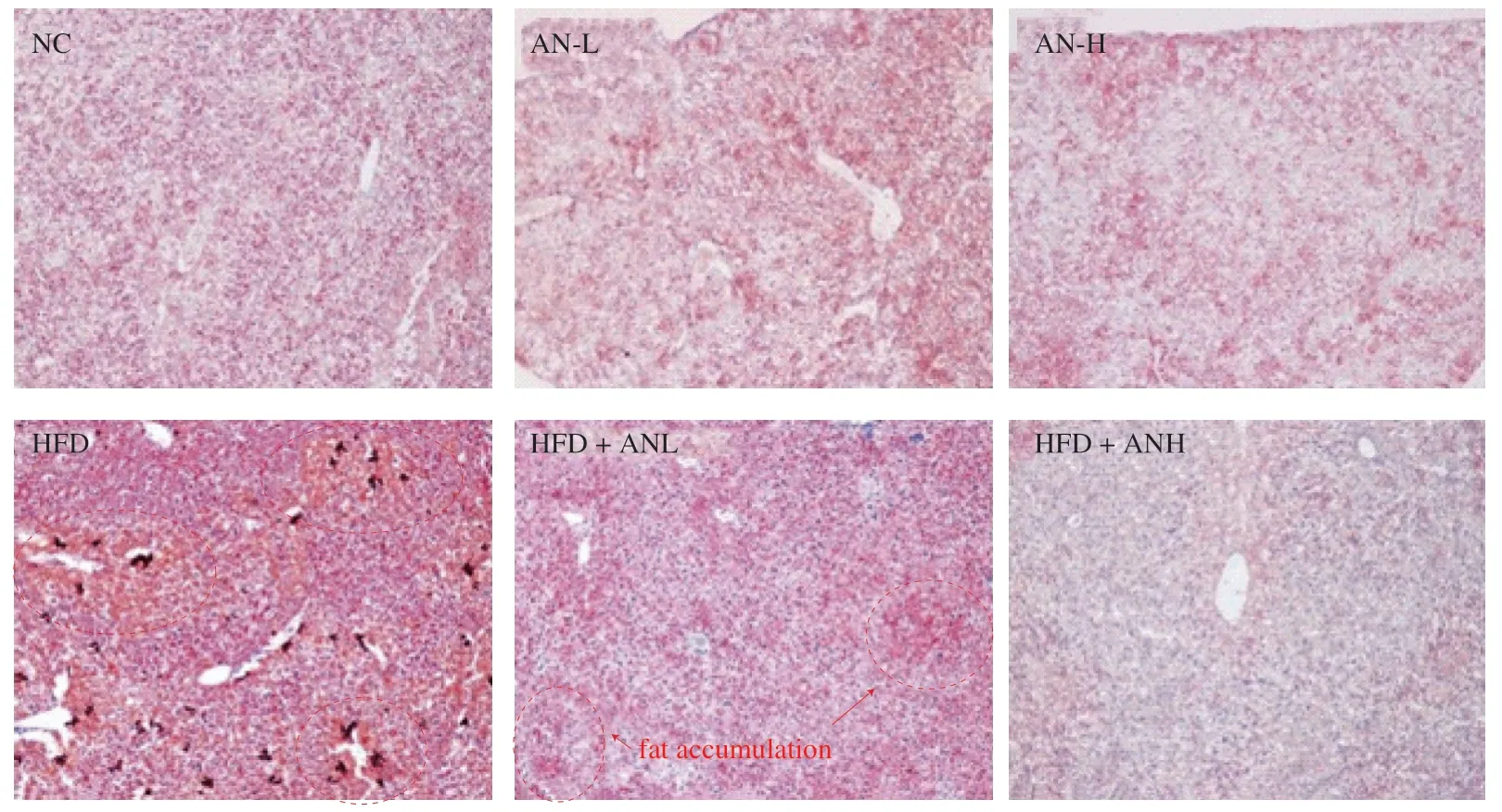
Fig.2 A.polytricha noodles reduced lipid accumulation in hepatic cells.Histological changes in frozen liver sections were measured by Oil Red O staining at 100 × magnification.
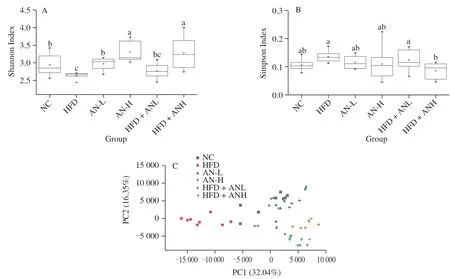
Fig.3 Effect of A.polytricha noodles on overall structural change of gut microbiota.Individual variation of fecal microbiota based on 16S rRNA gene sequences in different groups including Shannon index (A), Simpson index (B), and weighted UniFrac distance PCA (C).
In this work, the pyrosequencing of variable region 4 (V4) of bacterial 16S rRNA genes was performed to investigate the impact of HFD andA.polytrichanoodles on mice gut microbiota.The clean reads of the 48 samples (n= 8 for each group) were all more than 44 397 and 3 209 distinct OTUs.The Shannon and Simpson index curves revealed that the data had covered most of the diversity and new phylotypes (Fig.3A, 3B).As expected, the diets played a key role in shaping phylogenetic diversity based on theα-diversity including Shannon, Simpson, and InvSimpson index.The HFD significantly decreased the phylogenetic diversity of fecal microbiota, suggesting possible deficiency of healthy microflora after HFD treatment.Nevertheless, both low and high dose ofA.polytrichanoodles could ameliorate the microbiota phylogenetic diversity (Fig.3C).Additionally, compared with HFD group, Shannon and Simpson indices were significantly improved (P< 0.05) afterA.polytrichanoodles treatment.Furthermore, AN-H and HFD + ANH groups exhibited better effects on amelioration of the gut microbiota phylogenetic diversity.
PCA and community barplot (Fig.3C, 4A) based on OTUs abundance were used to show a distinct clustering of gut microbiota compositions from different treatments.The results showed that HFD group separately clustered from that of NC group (Fig.3C).Significant separation was also noted for AN-L, AN-H, HFD + ANL and HFD + ANH groups indicating thatA.polytrichanoodles had substantial effects on gut microbiota composition of HFD-fed mice.Moreover, PC1 accounting for 32.04% showed a higher total variance than PC2 accounting for 16.35%.A.polytrichanoodles could shift the HFD disrupted gut microbiota composition towards that of NC group, indicating that PC1 could reflect the effect of diet on the composition of gut microbiota.According to researches, diets play a dominant role to shape the structure of gut microbiota [18].Thus,A.polytrichanoodles could turn gut microbiota composition of HFD group back to normal status based on PC1.As expected, significant separation was also observed in the results of barplot for NC, HFD, AN-L, AN-H, HFD + ANL and HFD + ANH groups, which was consistent with the result of PCA (Fig.4A).Taxonomic profiling suggested that the gut microbiota structure of mice was mainly dominated by Firmicutes and Bacteroidetes at phylum level (Fig.4B-4D), which was consistent with published reports [19].The gut microbial community structure was obviously changed by HFD, with the relative abundance of Firmicutes increased while the relative abundance of Bacteroidetes decreased (Fig.4B, 4C).Therefore, the HFD feeding induced significant increase in the ratio of Firmicutes to Bacteroidetes compared to NC group (P< 0.05).Nevertheless,A.polytrichanoodles could signicantly attenuate the value to normal level.At family level, significant shifts in Porphyromonadaceae, Verrucomicrobiaceae, Ruminococcaceae, Lachnospiraceae and Lactobacillaceae after supplementation with HFD were observed compared with NC group (P< 0.05) (Fig.5).High dose ofA.polytrichanoodles treatment could reduce the relative abundances of Lachnospiraceae and Lactobacillaceae to the levels of NC group (P> 0.05) and enhance the relative abundance of Porphyromonadaceae, which is considered as a health-promoting species [20].It revealed that high dose ofA.polytrichanoodles treatment was more effective than low dose treatment for modulating the gut microbiota induced by HFD.
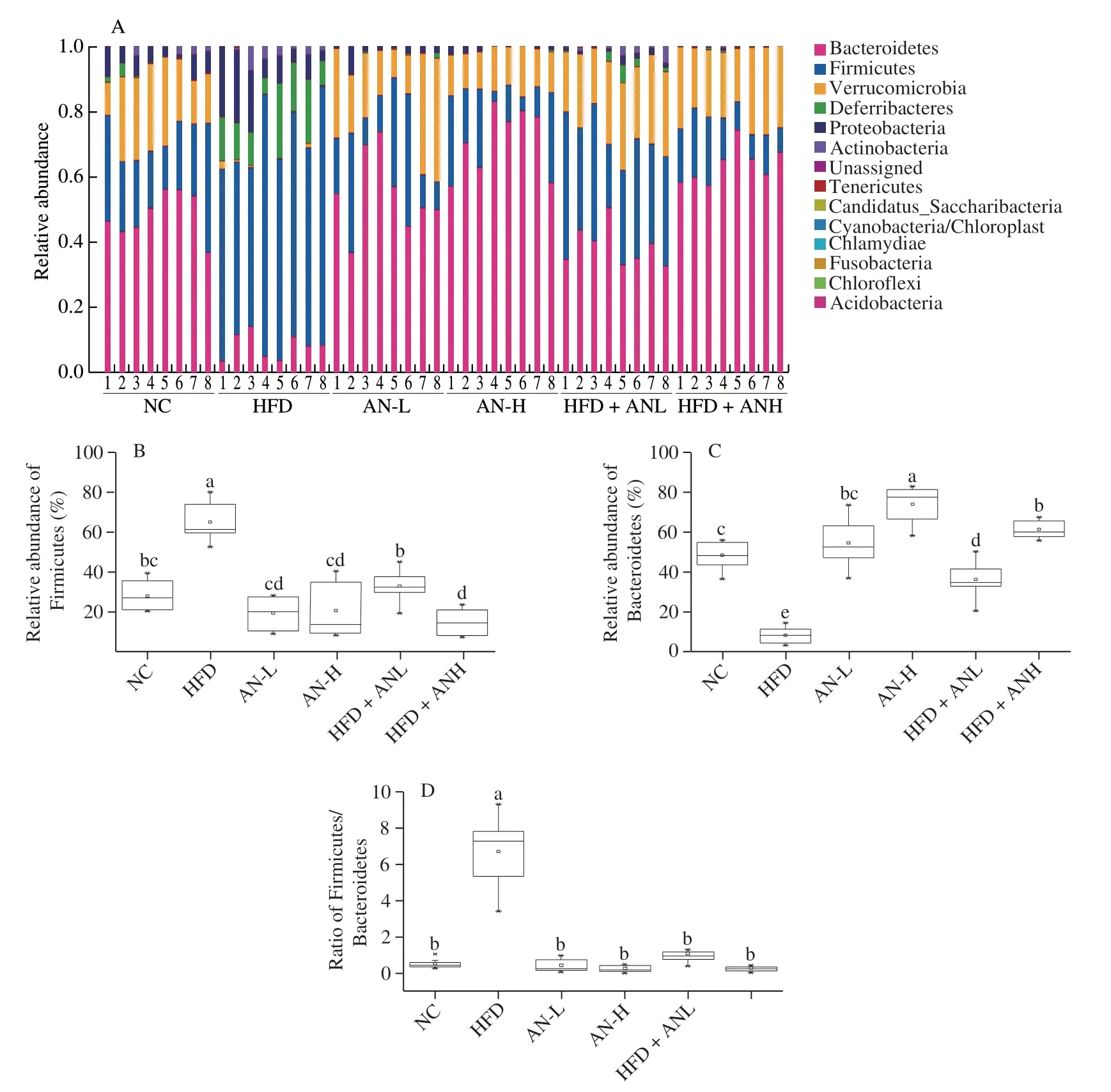
Fig.4 Gut microbial composition of mice at phylum level (A), relative abundance of Firmicutes (B) and Bacteroidetes (C), and ratio of Firmicutes/Bacteroidetes (D).
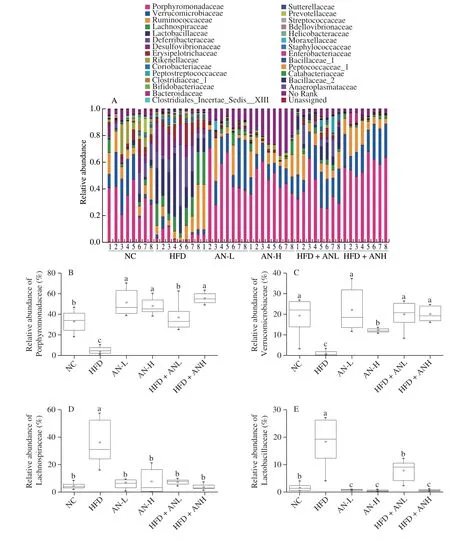
Fig.5 Gut microbial composition of mice at family level (A), relative abundance of Porphyromonadaceae (B), Verrucomicrobiaceae (C), Lachnospiraceae (D) and Lactobacillaceae (E).
The distribution and the relative abundance of intestinal microorganism at the genus level were shown in Fig.6.The HFD fed mice exhibited significantly (P< 0.05) lower relative abundance ofAkkermansiaand higher relative abundance ofLactobacillusat the genus level compared to control and otherA.polytrichanoodles fed groups.The relative abundance ofAnaerobacterium, which was positively associated with probiotic persistence [21], was significantly increased by feeding mice with low or high dose ofA.polytrichanoodles.It was noteworthy that the highest abundance ofBarnesiella, one of the beneficial bacteria that could dominate the proliferation of harmful bacteria [22], was observed in HFD-ANH group (Fig.6D).
4.Discussion
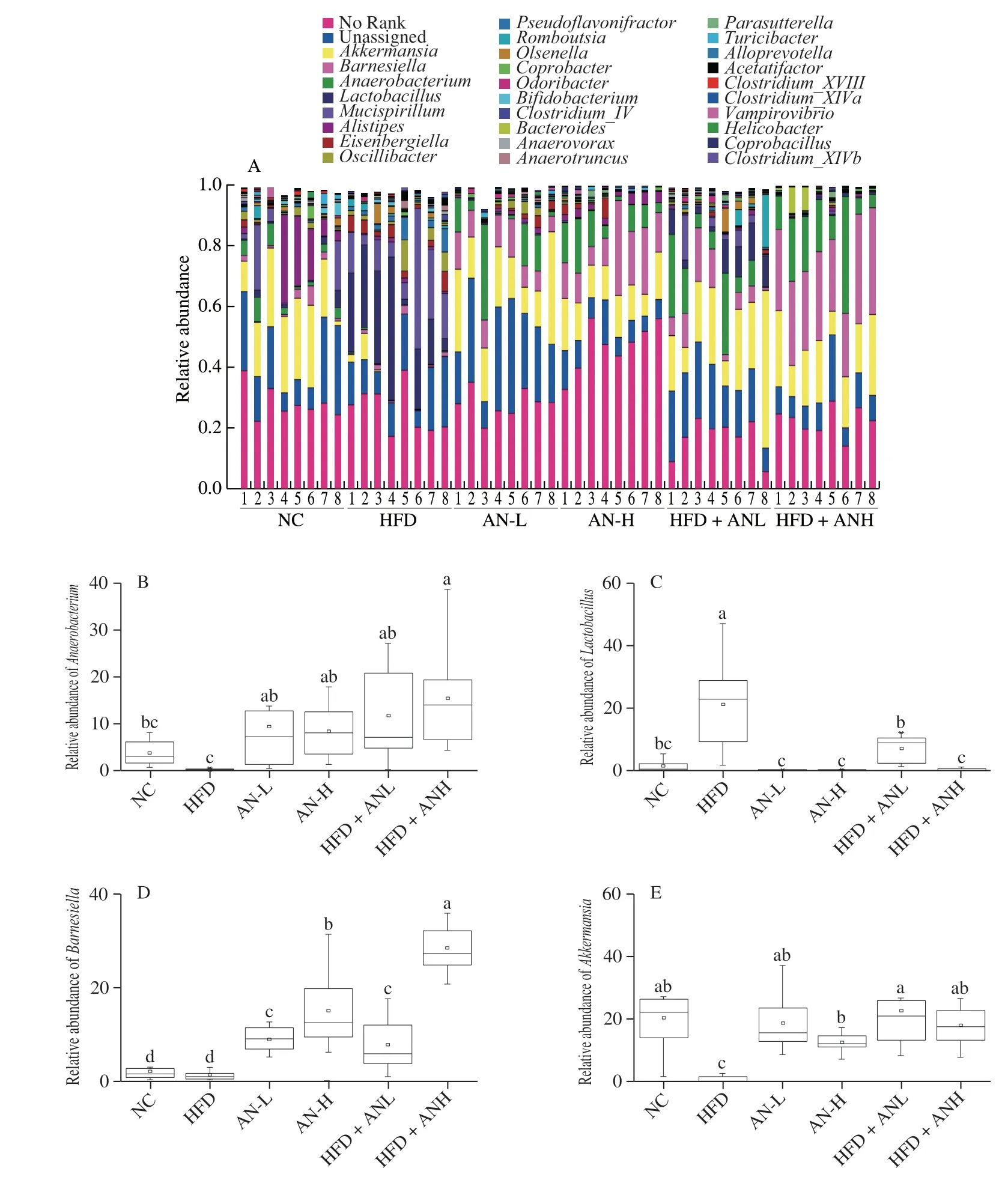
Fig.6 .Gut microbial composition of mice at genus level (A), relative abundance of Anaerobacterium (B), Lactobacillus (C), Barnesiella (D) and Akkermansia.
Hyperlipidemia induced by HFD is associated with atherosclerosis, cardiovascular diseases and intestinal microflora disorders [23].Increasingin vivoandin vitrostudieshave shown that dietary intake of edible mushroom was an effective strategy for hyperlipidemia prevention [24]and non-alcoholic liver injury [25].It has been demonstrated thatA.polytrichaconsumption could decrease the serum concentrations of blood lipid induced by HFD feeding [10].Furthermore,Auricularia auricular, a related species ofA.polytricha, has been shown to enhance the abundance ofBifidobacterialsandBacteroidales[3].It was thus worth investigating whetherA.polytrichanoodles also could prevent hyperlipidemia and modulate gut microbiota in a similar manner toA.polytricha.In order to investigate the hypolipidemic effects ofA.polytrichanoodles,A.polytrichanoodles were tested for the capacity to prevent hyperlipidemia and modulate the gut microbiota using C57BL/6N mice model and the groups fed standard diet with administration ofA.polytrichanoodles were also included in the present study.
In this study, 8-week HFD feeding resulted in a significant increase in body weight, serum lipid profile, and hepatic lipid accumulation in mice compared with NC group.These findings were in harmony with a previous study [26].It was proved that body weight gain would result in the increase in blood pressure and blood glucose levels [27].Our results revealed thatA.polytrichanoodles supplement effectively alleviated HFD-induced hyperlipidemia in mice through decreasing the serum TC, TG and LDL-C levels and increasing the serum HDL-C level.The serum TC and TG levels are considered as key risk indicators of hyperlipidemia and atherosclerosis [28].LDL-C is one of the major contributors to lipid metabolic disorders.Excessive LDL-C in serum could induce apoptosis and inflammation [29].HDL-C is responsible for transferring cholesterol from peripheral tissues to the liver [30].We tentatively speculated thatA.polytrichanoodles may be beneficial in promoting the transportation of TC and TG from plasma to liver by increasing the serum HDL-C level and reducing the serum LDL-C level.
Liver is the most important organ for lipogenesis and metabolism of lipids and energy [31].Lipid drops are usually accumulated in hepatic tissue and induces structural and functional changes of liver, eventually causing lipid metabolic disorders, especially hyperlipidemia [32].Thus, reducing fat accumulation in liver can prevent the development of hyperlipidemia.Our results indicated that the HFD-induced hepatic lipid accumulation was evidently observed with abnormal hepatic indexes, which was consistent with a previous report [33].Hepatic TC plays a substantial role in the development of hyperlipidemia mellitus, thus improving hepatic TC may be a therapeutic approach for the treatment of hyperlipidemia.The possible mechanism ofA.polytrichanoodles in lowering the hepatic TG level is through decreasing activity of triglyceride-synthesizing enzymes in the liver [34].
Gut microbiota plays a vital role in the development of hyperlipidemia.A variety of bioactive substances from foods have significant positive impact on gut microbiota and can be used for the prevention or treatment of hyperlipidemia [35].In this study, HFD consumption induced significant changes of the composition of gut microbiota, which is consistent with the previous study [36].However, oral administration ofA.polytrichanoodles significantly modulated the composition of gut microbiota in HFD-fed mice.A.polytrichapolysaccharides including cellulose, hemicellulose and other dietary fibers are generally poorly absorbed, and the beneficial health effects of edible mushroom may be ascribed to the metabolites generated by the gut microbiota from the polysaccharides [37].Moreover, the gut microbiota may regulate energy harvest which is related to hyperlipidemia [38].Therefore, we hypothesized thatA.polytrichanoodles might prevent body weight gain and fat accumulation through modulating the gut microbiota.It was found that obese individuals have lower microbial diversity than lean individuals [39].Our present results showed thatA.polytrichanoodles could enhance the microbial diversity, which was in congruence with the report that mushroom intake could significantly increase the microbial diversity [40].Moreover, HFD administration could lead to typical obesity-driven dysbiosis in the gut microbiota by increasing the relative abundance of Firmicutes and decreasing therelative abundance of Bacteroidetes[41].On the other hand, supplementation with diet fiber, polysaccharides, and other functional ingredients could reduce the ratio of Firmicutes to Bacteroidetes, which contributed to the prevention of body weight gain induced by HFD [42].In the present study,A.polytrichanoodles was shown to reduce the ratio of Firmicutes to Bacteroidetes, suggesting thatA.polytrichanoodles could attenuate hyperlipidemia induced by HFD by modulating the structure of gut microbiota.
More than 70% of the ingredients in mushroom are carbohydrate substances including noncellulosic polysaccharides, cellulose, hemicellulose and other dietary fibers [43].Mushroom polysaccharides are hardly absorbed in human body and the beneficial health effects of edible mushrooms may be ascribed to the metabolites resulting from the polysaccharides breakdown by the gut microbiota [44].The gut microbiota may regulate lipid metabolism which is related to hyperlipidemia [45].We therefore hypothesized thatA.polytrichanoodles might prevent serum lipid gain and hepatic fat accumulation through modulating the gut microbiota.It has been recognized that hyperlipidemic individuals have lower microbial diversity than normal individuals [46].In previous study, we found thatA.polytrichanoodles could enhance the microbial diversity, which was in agreement with the report that dietary mushrooms have prebiotic effect on the host intestinal microbiota composition [47].Supplementation with polysaccharides or any other functional ingredients such as dietary fibers could reduce the ratio of Firmicutes to Bacteroidetes, which contributed to the prevention of lipid metabolic disorder induced by HFD [48].In the present study,A.polytrichanoodles could significantly reduce the ratio of Firmicutes to Bacteroidetes, suggesting that the modulation of gut microbiota to ameliorate lipid metabolic disorders might contribute to attenuating the hyperlipidemia induced by HFD.
A previous work showed that lower level of Lactobacillaceae alleviated lipid metabolic disorders in HFD fed mice [49].In the present study,A.polytrichanoodles reduced the relative abundance of Lactobacillaceae to the level of NC group (P> 0.05).Therefore, hypolipidemic effect ofA.polytrichanoodles might be due to the decrease in relative abundance of Lactobacillaceae.Porphyromonadaceae has the capability to regulate lipid metabolism and immune response [50,51].Thus, the increased relative abundance of Porphyromonadaceae byA.polytrichanoodles administration might contribute to the prevention of hyperlipidemia.Increase in the relative abundance of Bacteroidaceae was observed with the treatment ofA.polytrichanoodles in the present study.Similarly, an increase in the relative abundance of Bacteroidaceae was shown from an intervention withGrifola frondosain HFD fed rats [52].At the genus level, the HFD fed mice exhibited significantly (P< 0.05) lower relative abundance ofAkkermansiacompared to control and otherA.polytrichanoodles fed groups.Akkermansiais a genus of bacteria whose abundance is inversely correlates with obesity, diabetes and several other intestinal disorders such as inflammatory bowel disease and appendicitis [53].The intake ofA.polytrichanoodles significantly increased the relative abundance ofAkkermansia, indicating a potential treatment forA.polytrichanoodles by manipulating gut microbiota in favor ofAkkermansia.
The current model of obesity induced by HFD has been reported to be largely due to the increased serum lipid levels and gut microbiota dysbiosis [54].Furthermore, the polysaccharides fromA.polytrichacould safely reach the large intestine without being broken down in simulated digestive system and the polysaccharides could then be broken down for utilization by gut microbiota resulting in significant modulation of gut microbiota [55].Therefore, it was hypothesized that the possible mechanism of hyperlipidemia prevention byA.polytrichanoodles might be that the indigestible compositions ofA.polytrichanoodles reached the large intestine and then modulated the gut microbiota.However, the mechanisms of gut microbiota modulation and hyperlipidemia prevention by ingredients inA.polytrichanoodles should be further investigated in detail.Meanwhile, the metabolites produced by gut microbiota, such as short-chain fatty acids play an important role in metabolic health [56].In future, it would be interesting to determine the metabolites profile ofA.polytrichanoodles in the large intestine to ascertain these molecules’ contribution to the hypolipidemic capacity.
5.Conclusion
In conclusion, the high dose ofA.polytrichanoodles treatment decreased serum TC, TG and LDL-C levels, and improved hepatic fat accumulation in HFD-fed mice.Furthermore, the compositional alteration of gut microbiota induced by HFD treatment could be modulated through the ingestion ofA.polytrichanoodles.In particular, high dose ofA.polytrichanoodles reduced the relative abundance of Lactobacillaceae and enhanced the relative abundance of Porphyromonadaceae,which might be associated with the observed hypolipidemic activity ofA.polytrichanoodles.Therefore,A.polytrichanoodles could prevent hypolipidemia and ameliorate the structure of gut microbiota.
Conflict of interest
There are no conflicts of interest to declare.
Acknowledgement
This work was financially supported by the China Agriculture Research System (CARS-20) and the Jiangsu Provincial Key Research and Development Program (BE2019323).
杂志排行
食品科学与人类健康(英文)的其它文章
- Antioxidative and hepatoprotective activities of a novel polysaccharide (LSAP) from Lepista sordida mycelia
- Phylogenetic analysis and protective effects of thymol and its chromatographic fractions from a novel wild mushroom in combating oxidative stress
- Immunomodulatory effects of polysaccharides from edible fungus: a review
- Advances in research on chemical constituents and pharmacological effects of Paecilomyces hepiali
- Healthy function and high valued utilization of edible fungi
- Antrodia Cinnamomea ameliorates neointimal formation by inhibiting infl ammatory cell infi ltration through downregulation of adhesion molecule expression in vitro and in vivo
